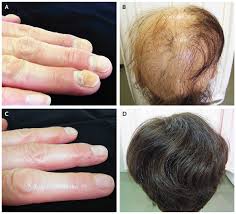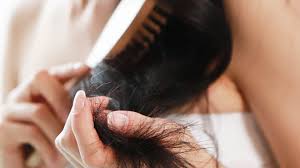Demystifying Common Hair and Nail Disorders:
Demystifying Common Hair and Nail Disorders: A Comprehensive Guide

Our nails and hair are an external expression of our health and well-being. However, many factors can affect their development and normality, resulting in serious diseases that affect millions of people worldwide. It is important to understand these conditions in order to properly manage and treat them. In this guide, we’ll cover some of the most common hair and nail conditions, including causes, symptoms, and treatments.
Alopecia Areata:
An autoimmune disease called Alopecia Areata causes hair loss, usually in small, circular areas on the scalp or elsewhere on the body. Hair loss occurs when the immune system mistakenly attacks the hair follicles. Some symptoms include sudden hair loss, skin irritation, and sometimes stinging or itching in the affected area. Injectable corticosteroids are a treatment option, as are topical and anti-inflammatory medications.
Seborrhea or dandruff:
A dandruff-like condition of the scalp, characterised by flaking, itching, and itching. It is caused by an overgrowth of yeast on the scalp, causing swelling and shedding of dead skin. Although dandruff is not harmful or contagious, it can be irritating and debilitating. Shampoos containing chemicals such as zinc pyrithione, ketoconazole, or selenium sulfide are often used as treatments to reduce flaking and control yeast overgrowth.
Nail fungus or onychomycosis:
Nail fungal infection that can affect the nails and fingers is called onychomycosis. It usually starts as a white or yellow area on the underside of the nail and can spread, thicken, discolor, and make the nail brittle. Factors such as heat, humidity, weak nails and weak immunity can increase the risk of fungal infections. Treatment may include antibiotics, oral antibiotics, or in severe cases, surgical removal of the affected nail.
Psoriasis:
An autoimmune disease that affects the skin, nails and joints is called psoriasis. When the nail is affected, changes such as pitting, color change, thickness, and separation of the nail from the nail bed will occur. Psoriatic nail changes are often accompanied by skin symptoms such as plaques, which are red, scaly patches on the skin. Medications, phototherapy, vitamin D analogs, and topical corticosteroids may be used to treat nail psoriasis.
Hair problems (split ends):
When the cuticle, which is the protective layer of the hair, is damaged and begins to wear out, causing the hair to break, split ends occur. Broken broken. Common causes include damage from scrubbing or brushing, chemical treatments, excessive heat, sunlight exposure, and environmental factors such as pollution. Prevention measures include reducing exposure to heat and chemicals, getting regular trims, and using treatments that will moisturize and strengthen hair.
In Summary:
Hair and nail problems can vary in impact and severity, but many can be effectively treated or managed with knowledge and proper care. . For an accurate diagnosis and self-treatment plan, you should see a dermatologist or other doctor if your symptoms are severe or persistent. By taking good care of your hair and nails and dealing with any health issues, we can help you improve the health of your hair and nails and keep them looking beautiful for next year.
